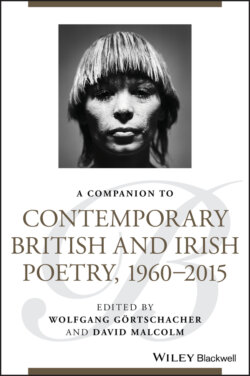Читать книгу A Companion to Contemporary British and Irish Poetry, 1960 - 2015 - Группа авторов - Страница 29
David Constantine, “Visiting” (2002) (Constantine 2004, 305)
ОглавлениеThe title points to an everyday experience and one that is a mainstay of lyric verse—a visit to a place associated with the speaker's past, in this case, a childhood garden seen from an adult perspective (ll. 5–8). However, this experience—often disturbing enough in itself—is turned into something sinister, sorrowful, and macabre.
The text is divided into three sections (of eight lines, six lines, and two lines). The first section is an account of a visit to a garden known from childhood and of the speaker's (who is not present as a personal pronoun here) response to change. The second section reveals that there are ghosts within the garden, and in it the speaker (now an “I”) considers how he might wait to encounter them, perhaps until death, the “time of the naked soul” (line 11). The final two lines form a most ambiguous conclusion. The ghosts are thin, but the “I” is infinitely thin. Is the speaker a ghost forever banned from return, from reunion with the others whom he seeks to embrace?
The shift from the quotidian to the metaphysical, from the everyday to myth is embodied in a linguistic movement. The “old way in” becomes a “locus” (line 3). The visitor becomes “naked somnambule” (no article). The garden has “iron gates” and a “pitbull” (line 4), dark lexis that contrasts with memories of pleasure in a suburban garden (“cricket,” “bonfire,” “snowman” [line 7]). The garden is utterly de‐suburbanized and estranged in the “bars” (line 12), “the foul dog” (line 13), and the insubstantial “multitude” who throng it (line 13). The garden becomes the underworld, guarded by Cerberus, haunted by the untouchable shades.
Indeed, the whole poem is marked by unsettling movement on various other levels too. On the level of form or genre, one must ask whether this is any kind of sonnet. The main body of the poem is divided into an octave and a sestet. The final couplet pushes one to wonder if it is a 16‐line sonnet. There is certainly a rhyme scheme, but it is fragmented and odd. There is no space to go into this here in detail, but a poem that rhymes “somnambule / pitbull” (ll. 3–4), or “there” (l. 6) with “enter” (in the distant line 11), is advertising its fragmentary inconclusiveness. The final line endings “I” and “infinity” court rhyme without achieving it. Line length is similarly disorderly: sections 1 and 2 have lines from 8 to 1 sections 1 and 2 syllables in length; the final couplet is made up of a six‐syllable line and a 10‐syllable line.
Rhythmically, the text is certainly marked by a recurrent caesura, although it divides each line nonsymmetrically. It is certainly not an iambic poem. Line 12 is the only clear example of a predominantly iambic line. While there are usually four to five main stresses in lines (although not in line 9, nor in lines 15 and 16), the poem is about as hard to scan as one of Thomas Hardy's elegiac pieces (on which it is surely modeled).
The poem enacts an unsettling move from commonplace to mythic. An uneasy, hopeless experience is embodied in a deviant sonnet with deviant rhymes. It ends on a sinister ambiguity. Who is the ghost?
